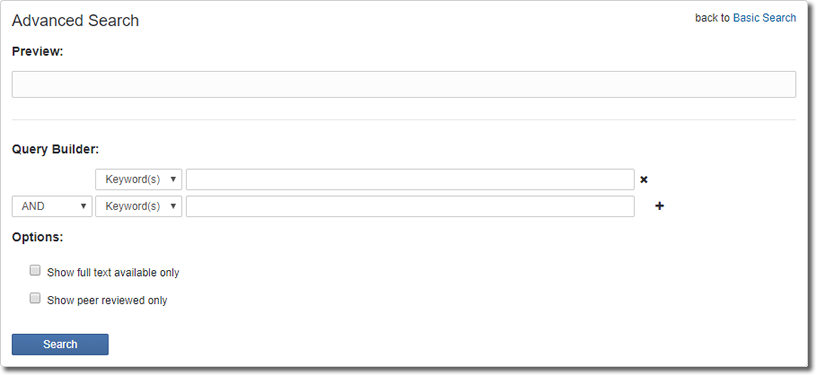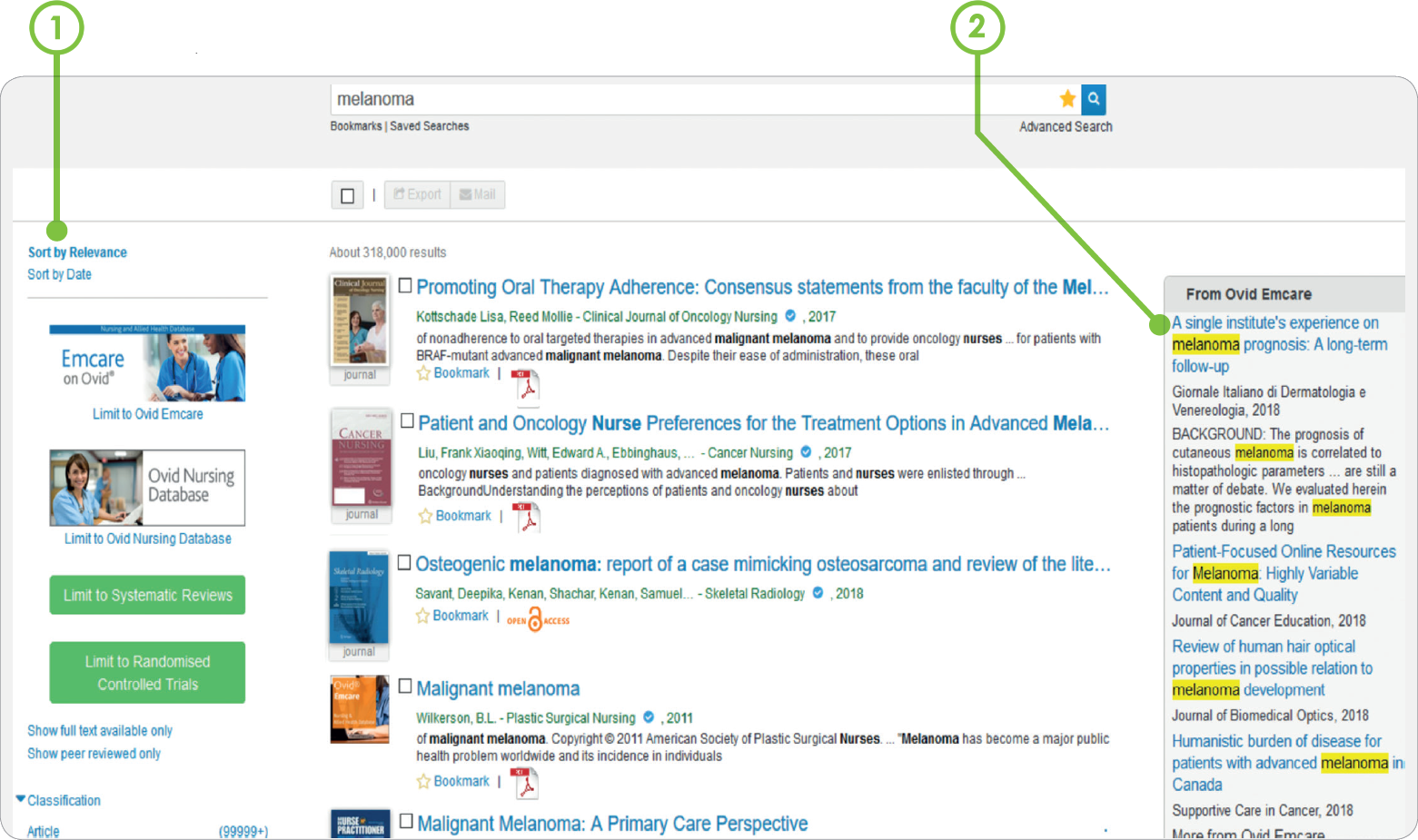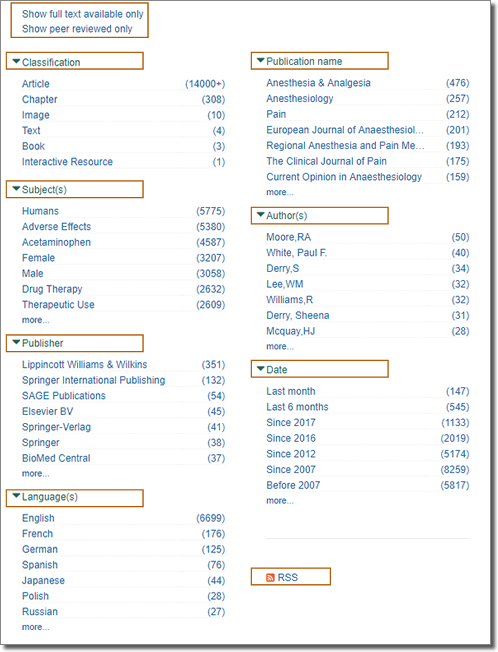


- Vastly increases resource discoverability and usage by providing a single search point to bibliographic records, full text, and multimedia
- Facilitates linkages to indexed and non-indexed resources including scholarly, free, and commercial publishers and information providers
- Offers a simple interface that requires little training and no cataloging
- Minimizes costs spent on document delivery and library portal maintenance
- Available in 12 languages — Arabic, Simplified Chinese, Dutch, English (US and UK), French, German, Hebrew, Italian, Japanese, Portuguese and Spanish
- Identifies missing content by offering sophisticated usage analytics that show frequently requested eResources
- Includes an advanced and easy to use A to Z tool for accessing and browsing eLibrary holdings
- Allows nurses to stay up-to-date on their favorite nursing journals with eTOC Alerts
- Combines cutting-edge bibliographic and full-text content, a search lexicon and vocabulary that “speaks nurse,” and a workflow solution—all in one!
- One-click, integrated searching of 27 nursing journals, 115 nursing eBooks, and millions of bibliographic records from Ovid Emcare, Ovid Nursing Database, and Ovid Discovery index
- Designed for nurses in practice, education, research, or management
- Ability to focus training efforts on only one search and discovery platform for your nursing needs
- Fully compliant with any mobile device!
Authoritative Full-Text Content from Lippincott
Ovid Emcare
Ovid MEDLINE Nursing Subset
Ovid Discovery
Nurses in clinical situations at the bedside — instant access to clinically oriented information when you need it
Advanced practice nurses and researchers — deep-dive literature searching for short- or long-term research projects or patient care
Faculty members and other educators — involved in basic, advanced, or continuing education curriculum development and teaching
Nurse managers — improves efficient access to information, leading to better patient and clinical outcomes
In order to access the platform, you must either:
1. Be accessing the platform from a recognized IP address; or
2. Be accessing the platform from a network that is integrated with SSO (Single Sign-On); or
3. Be accessing the platform via the Athens SSO provider; or
4. Log in with a user name and password.
If you are accessing the platform by any of the first three methods (i.e., without logging in), you can still use all three search engines freely without having to log in. You can also check if your institution has access to the full text of your items, and export or email article information. However, you will not be able to save searches, bookmark items, or receive TOC alerts without creating an account.
To log in, click on Log in in the upper right corner of any screen. The login form will appear:

If you want the platform to recognize your current computer and log you in automatically in the future, check the Remember me box. To log in, enter your username and password, and click Submit.
If you have forgotten your password, click on the Forgot account details link. The password retrieval screen will appear:

Enter your username and click Send request to receive an email with a link that you can click on to reset your password. That link will bring you to the reset password screen:

To reset your password, enter your new password in both fields and click Reset.
Some aspects of the sign in screens, such as their color schemes and banners, may be customized by your institution.
To log out of your account, simply click Log out in the upper right corner of any screen.
You will be returned to the search screen if you are accessing the platform from a recognized IP address; otherwise you will be returned to the log in screen.

Discover is the main search window and it is the primary method of finding articles on the Ovid Nursing Edge databases.
It allows you to search for journal articles, book chapters, dissertations, and other content types available through Ovid Nursing Edge.
Overview
The main search screen contains the following elements:
- The text box into which the search term is entered (1);
- The Search button (2);
- The advanced search button (3).

As with all other screens in the platform, the upper right corner contains links to log in, log out, and/or sign up; below these are links to your user account and to the other search methods available on the platform. Some aspects of the search screen, such as its color scheme and banner, may be customized by your institution.
To access the search screen, click Search in the upper right corner from any other screen in the platform.
To perform a simple search using the default settings, enter your search term in the text box in the center of the screen, and then click the Search button immediately to the right:

The Search Results Screen will then appear, displaying those articles that include each and every word entered into the text box.
For more customized search parameters, see the Advanced Search section below.
In order to run an advanced search, click the Advanced Search option under the Search button. The advanced search options will appear:

Each row in the advanced search consists of following elements:
- The middle element is the text box, into which you should enter the word or words you wish to use in your search.
- On the left is a drop-down menu that contains a list of fields:

- Below this is a drop-down menu that lists common Boolean relationships between search terms:

AND indicates that the search term(s) in the following row must appear in addition to the one(s) in the current row.
OR indicates that the search term(s) in the following row can replace those appearing in the current row.
NOT indicates that the search term(s) in the following row must not appear in the search result.
- The last row, since it does not have a row following it, does not have a drop-down menu; instead it contains a + symbol that can be clicked to add an additional row. When there are more than two rows, all rows but the last offer an X symbol that, when clicked, deletes that row.
For example:

The above search terms will search for articles on the subject of “Endangered species” that refer to either orangutans or tigers, so long as their author is named Smith.
- Finally, there is a drop-down menu that allows you to limit your results to a given date range:
If you select Custom, four additional drop-down menus appear, allowing you to specify starting and ending dates by month and year:
When you have completed entering your search criteria, you can click on the new Search button that appears at the bottom of the advanced search window. If you wish to return to the simple search, click the – button in the upper right (which appeared in place of the + button you used to open the advanced search window).
The Search Results screen is made up of these sections:

- ( 1 ) Sort your full text search results by relevance or date by using the tools on the left. You can also limit your search results by subject, language, publisher, author and many other variables. Filter by whether results are full-text or have been peer-reviewed. When you select a filter, it refreshes the results and displays above the search box.
- ( 2 ) Ovid Nursing Edge uses the MeSH thesaurus and the Nursing@Ovid Thesaurus, and includes an American English/UK English spell check system.

Click on a search result to see the Results Detail page:
- ( 1 ) From here, you can view the abstract, export the citation in several formats, search for the article in UpToDate or Google Scholar, or request that your library purchase the full text.
Above the search results is a small banner with various options (not all of these options are available to users who are not logged in):

- The Export button opens a small screen with all the export options available (the order can be changed, and some options can be removed):

Select what aspects of the selected item(s) you want to export (citation information or the full details) and the format in which you want to receive it, and then click Export. You will then be offered to download a text file containing the information you requested.

- The Mail button opens a small screen with three text boxes:
- Additional information about the result. This may include an external link to the collection from which it was retrieved, the date of the result, the result’s author(s), and/or an excerpt from the abstract.
- The Save Search link stores the current search parameters in the Saved Searches section of My Profile. This link can only be accessed if you are logged in.
- The Edit Search link returns you to the main search screen, where you can make changes to your search criteria.
At the bottom of the search results are links to move back and forth between the results that have been obtained:

At all times, the ten pages immediately surrounding the current page are available to be clicked on, as are the first two and the last two. In addition, the << and >> icons take you to the immediately preceding and immediately following pages, respectively. Each page contains 20 results, and there is a maximum of 5000 results, for 250 pages.
On the left of the Search Results screen you will find two means of filtering the results: full text only or peer reviewed only. Below you have a series of clickable categories:

To use, for example, the Full text available filter, click in that option. This has the effect of adding that filter to your original search. The Search Results screen will refresh with the new set of results, and an icon indicating your new filter will appear above those results:

Clicking in the X of the filter will remove it. If it was the only filter, your original search will be displayed; if there are other filters, a new search will be run using those filters alone.
Some categories, such as Year, only allow one selection (because an item cannot be published in more than one year). Others, such as Publication type, remain available for further selection, because a single item can fall under more than one category (such as being both a Review and a Comparative Study).
Just as the Discover section of the platform allows you to search for individual items, Library eResources allows you to search for the resources from which those items are obtained.
The search process is much the same for each type of resource; for simplicity’s sake, this document will focus on searching for journals, but will use other examples where appropriate.
This screen displays a search window for the default resource type, with tabs that you can click to access other resource types.
The types of resources available are the ones include in Ovid Nursigng Edge: includes journals, e-books, books and databases.
In the sample image below, the default resource type is Journals, and any search conducted in this window will return journal results. Other resources are available. In order to access one of the other resources; simply click on the appropriate tab, e.g. e-Books, Databases.

Before you begin entering your search term, it is recommended that you first select what type of search you are conducting using the drop-down menu, or, like in the case below, select All:

- ( 1 ) Search or browse for the name or title of the resource in your collections, within books, journals, databases or other materials.
The platform allows you to browse through the available resources rather than running a search, by using the alphabetical selector:

To see all the journals that begin with a given letter, simply click on that letter, or click All to browse through all the journals available.
Depending on the institutional holdings, some alphabetical selectors may be missing letters if no resources begin with those letters:

My Profile is the portion of the platform that stores information relating to an individual user.
It can only be accessed if you are logged in. To access the various portions of the My Profile section of the platform, click on one of the tabs across the top of the screen: Personal details, My Saved searches, Discover Bookmarks, eResources Bookmarks and TOC alerts.
The Personal Details screen allows you to edit your first and last name and your email address, information that was inherited from your OpenAthens account.
To edit your details, please click in the Edit option.

( 1 ) - You can save your searches, bookmarks, and TOC Alerts.

( 1 ) - To save a search, select the star in the Discover search bar above your search results.

( 2 ) - In the My Profile section, you canthen choose to receive an alert when new results are found.

( 1 ) - To bookmark a search result, select the Bookmark star below it.

( 1 ) - You can sign up to any Ovid Nursing Edge journal’s TOC Alert to keep up-todate with the latest content on your favorite resource. To add a TOC alert, in My TOC Alerts click Add and search for the journal you want.
